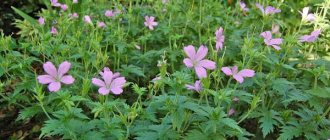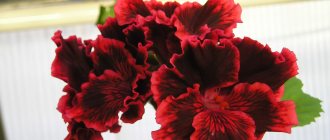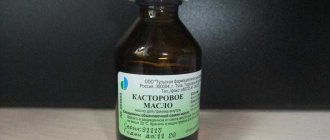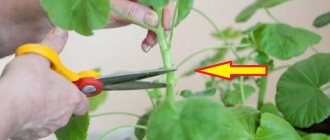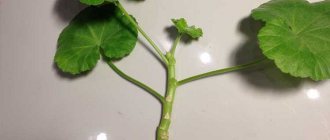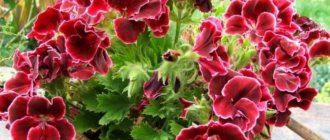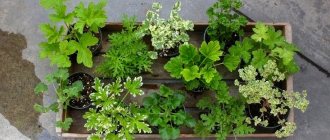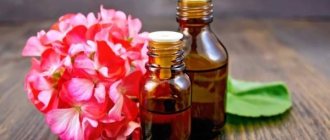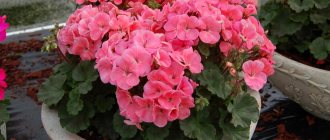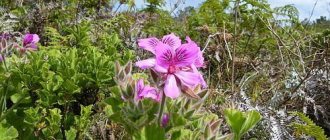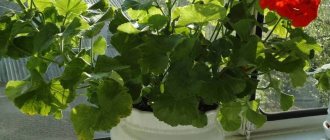Pelargonium (Pelargonium) is directly related to the Geranium family. This genus includes approximately 350 species of different plants, which are herbaceous perennials, but shrubs and succulent plants are also found.
This plant, grown at home, has one unusual property. So, its aroma can calm and relax some people, while others feel worse when inhaling it. Only a few species are grown indoors, but the choice is quite rich.
Pelargonium has a rather spectacular appearance. However, that's not all. It contains substances that are used in medicine and perfumery. Thus, the essential oil obtained from this plant is used to create perfumes and soaps, and it is also used in products for purifying the air from pathogenic bacteria and harmful impurities.
Aroma and properties of geranium oil
To obtain geranium essential oil (aka pelargonium), geranium leaves are first used - it is there that the maximum concentration of components is contained, which gives the essence a tart, sweetish-spicy aroma with bitter notes.
However, in some cases, the entire plant along with flowers is used for production. In perfumery, geranium plays in the “heart” of the aroma composition in both women's and men's perfumes. The fragrant pelargonium of the product lifts your spirits and promotes relaxation. It is effective in combating obsessive fears and anxieties.
Geranium pelargonium leaves are converted into essential oil using steam distillation.
The ether has a number of healing properties, including:
- rejuvenation;
- regeneration;
- antispasmodic effect;
- antifungal and antiparasitic effect;
- increased mental and physical activity;
- normalization of hormonal levels.
Geranium oil also strengthens the immune system, gives a boost of vigor and energy, and helps fight not only age-related changes in the skin, but also treat damage to the dermis.
Description
Pelargonium gravel
The shrub is erect, branched, grows up to 1.5 m and has a height of 1 m. The leaves are deeply incised, velvety, soft to the touch (due to glandular hairs).
Flowers range from pale pink to almost white, and the plant blooms from August to January. The leaves may smell strongly of rose, although the shape and scent of the leaves may vary. Some plants have a very strong smell, while others have almost no smell. Some leaves are deeply cut, others less so, [5] being slightly lobed, like P. capitatum
.
Application and benefits of oil
Geranium essential oil is often used in the fight against depression. The product is also recommended for use in order to improve performance. The product is effective for:
- combating self-doubt;
- restoring mental balance;
- adequate assessment of events.
How else can you use pelargonium essential oil? It is used for diseases of the oropharynx, sinuses and ears. It is also used in dental practice. The product not only relieves inflammation, but also eliminates pain. Geranium essential oil is used for fungal skin infections, eczema, burns, dermatitis, neuroses and other diseases.
In everyday life, geranium is used to combat insects, for which the smell of geranium is disgusting. Therefore, pests quickly leave the place where the aroma of the plant is fragrant.
Caring for pelargonium at home
Illumination
This plant is quite light-loving and requires direct sunlight for normal growth. It is recommended to place pelargonium near south-facing windows. However, it grows and develops quite normally even near a north-facing window, but it is important that the daylight hours are long enough. Otherwise, the stems will stretch. In the summer, if possible, this plant is transferred to fresh air (to the balcony or to the street). The room in which pelargonium is located must be regularly ventilated, as it reacts negatively to stagnant air.
Temperature
In summer, the plant needs a temperature of 20 to 25 degrees. In winter, it is necessary to move it to a fairly cool place to ensure normal flowering. In winter, the temperature in the room should not be more than 14 degrees.
How to water
In summer, watering is recommended 3 or 4 days after the top layer of the substrate has dried. You can check the condition of the soil by carefully digging your finger a couple of centimeters. In winter, you need to water a little less, but you need to make sure that the earthen ball does not dry out completely. If, during a cool winter, liquid stagnates in the soil, this can provoke the appearance of root rot, which often leads to the death of the entire bush.
Spraying foliage
It grows and develops normally at low air humidity. It is not necessary to mist the foliage with a spray bottle, but it can be done during the hot summer months.
Fertilizer
The plant is fed 1 or 2 times, with the interval between feedings being 2 weeks. Fertilizers are applied to the soil for the first time when 2 months have passed after transplantation. Fertilizing is needed to improve flowering, so choose fertilizers containing a large amount of phosphorus. It is not recommended to feed with organic fertilizers, because pelargonium absorbs them quite poorly.
Trimming
Pruning should be done once a year, leaving stems with 2–4 nodes. As a result, the bush will be more lush and the flowering will be abundant. It is necessary to promptly remove yellowed or dried leaves. You cannot tear off the leaves, as in this case the torn edges may rot. To remove such leaves, it is recommended to use a very sharp knife, and the cut area should be treated with crushed charcoal. After trimming the leaf, the base of the petiole should remain on the branch.
Features of transplantation
Young plants are replanted once a year, and adults as needed, for example, when the roots no longer fit in the pot. Don't forget to make a good drainage layer at the bottom of the container. To prepare a suitable soil mixture with your own hands, you will need turf, humus and leaf soil, sand and peat, which should be taken in equal parts.
Reproduction methods
This plant can be propagated by cuttings and seeds.
When grown from seeds, plants very often lose varietal characteristics, and this is worth remembering when choosing a propagation method. A low container should be filled with a soil mixture prepared from sand, peat and turf soil, which should be taken in equal parts. Seeds are sown into it. In order for the seedlings to appear as soon as possible, the container is placed in a place where the temperature is constantly kept at 22 degrees. In such favorable conditions, seedlings appear half a month after sowing. The seedlings are transplanted into separate small pots. And after the plants grow from them, they are transplanted into pots whose diameter is 9 centimeters. The plant should bloom for the first time a little over a year after sowing, but this is only with proper care.
Tip cuttings are excellent for propagation. Their cutting and rooting is carried out in the last winter or summer weeks. The cut should be made at an angle slightly below the node, while at least 3 leaves should remain on the cutting, and it is better if there are 3-5 of them. Leave the cutting outdoors for several hours to dry. Before planting it, you need to treat the cut areas using crushed charcoal and a root growth stimulator. In a container filled with an earth mixture (sand, turf soil and peat in equal proportions), prepared cuttings should be planted around the perimeter. To increase the splendor of the bush, it is recommended to pinch the cuttings. The container is placed in a well-lit place, but the light should be diffused. It is necessary to systematically moisten the soil using a sprayer. Complete rooting will occur 15–20 days after planting. Strengthened plants are planted in separate containers. The pot for planting is chosen to be small, as otherwise the flowering will be poor. The plant will bloom 5–7 months after complete rooting.
Pelargonium: propagation by cuttings
Virulence
Some types of pelargonium are poisonous. If you do not know for sure whether the species growing in your home is poisonous, then you need to be careful when working with such a plant. So, be sure to wash your hands well after working with it.
Diseases and pests
Aphids or whiteflies can settle on pelargonium.
In most cases, problems with the plant are associated with improper care:
- Lack of flowering - pelargonium is sick, there are harmful insects on it, or it overwintered in a warm, well-lit room.
- The lower leaves fade, turn yellow and rot - abundant watering. Reduce watering and carefully remove affected leaves.
- Swellings appear on the surface of the foliage - water often stagnates in the soil.
- The lower leaves turn yellow and their edges dry out - poor watering.
- The base of the stem has turned black - root rot (Black leg).
- Gray rot - due to too much watering.
Benefits of geranium oil for the body
Pelargonium ether is used in massage mixtures. The procedure helps not only to relax the body, but also to tone the skin. The ether nourishes, softens and improves its elasticity.
In addition, anti-cellulite wraps are made based on the essence. The product is involved in activating blood circulation in problem areas and promotes more active burning of fat deposits - naturally, together with physical activity.
For cuts, burns, frostbite and other skin injuries, it is appropriate to make medicinal compresses with pure pelargonium oil.
Landing
Before planting the plant, you need to prepare the soil, pot and choose a place for the flower. It is important to remember that the plant will bloom annually only if all recommendations are followed.
Choosing a pot
The pot should be only a few centimeters higher than the previous planting site. If the flowerpot is too spacious, the plant will spend a lot of energy on root formation and will not bloom. There must be drainage holes at the bottom of the pot.
A pot that is too cramped is just as harmful to the plant as a pot that is too spacious. In a limited volume, pelargonium will not be able to fully grow and develop.
Soil composition
Recommended by topic
Stromantha Night Violet Aloe
Pelargonium is undemanding to soil composition, but prefers nutritious soils with good breathability. The main thing is that the soil is not heavy, sandy or clayey.
Composition 1:1:
- peat;
- overflowed
Composition 1:1:2:
- peat;
- sand;
- turf land.
A drainage layer of small pebbles, expanded clay or brick must be poured onto the bottom of the pot.
Planting pelargonium
Young seedlings are deepened into the soil by 2–3 cm, and adult plants so that the root collar remains on the surface. It is best to replant the plant by transshipment without breaking the earthen coma. The first days after planting, it is best to keep the plants in the shade and only then place them on windowsills with diffused light.
Transfer
Young pelargoniums are replanted approximately once a year until the age of three. Adult plants are replanted only when the root fills the entire pot. Sometimes pelargoniums are transplanted to summer beds or to treat diseases.
Aromatherapy with geranium oil
Aromatherapy with pelargonium oil has a positive effect on the digestive system, heart and blood vessels. It can be successfully used for such cardiac disorders as:
- arrhythmia;
- tachycardia;
- ischemia.
A positive effect is also observed with high blood pressure.
Inhaling the aroma of geranium will help you overcome attacks of aggression, calm down, get into a working mood and restore your energy. For these purposes, the essence is added to personal aroma pendants, inhaled and added to aroma diffusers.
Reproduction methods
There are two main methods for growing pelargonium at home. But cuttings are usually used, since it is quite simple and allows you to obtain bushes that retain all the varietal qualities of the mother plant. Seed propagation is quite complex and labor-intensive. It also does not guarantee that young seedlings will retain varietal characteristics. This method is usually used by experienced gardeners to breed new varieties of pelargonium.
Cuttings
Experienced gardeners do not recommend carrying out the cutting procedure annually.
Homemade pelargonium simply will not have time to regain strength in 12 months and grow new planting material. The optimal time for collecting cuttings is once every 2 years. If the plant is young or weakened, then it is best to take breaks of three or four years.
Question to the expert
When is the best time to collect cuttings for planting?
Tender green cuttings are collected from March to September. Semi-lignified ones are best collected from late summer to October.
Collecting cuttings can be carried out regardless of the time of year. But most gardeners postpone cuttings until spring and combine it with sanitary pruning. All parts of the plant that are cut off during processing can be rooted and planted.
Both apical and lateral shoots are suitable for cuttings.
Recommended by topic
Hippeastrum Fritillary Rosemary
Cutting stages:
- The cuttings are cut at an angle so that a knot and several leaves remain on it. Excess growth and leaves are removed.
- The seedling is dried in the open air for a couple of hours. The cut points on the seedling and the mother bush are sprinkled with activated carbon, fungicide or ash.
- The dried cuttings are planted in previously prepared soil made of sand, peat and turf soil.
- Containers with seedlings are placed in a lighted, warm place and the soil is periodically moistened. It is important that direct light does not fall on the leaves. It is better if these are western or eastern windows. Optimal temperature is from +15 to +25 °C.
- Typically, cuttings take root 15–20 days after planting.
- Next, the young plants are planted in individual cups or pots, in which they will grow until the next transplant.
To increase the splendor and bushiness of a young seedling, you need to pinch the top.
Guseva Ulyana
Ask a Question
Question to the expert
When does pelargonium bloom for the first time?
If you follow all the rules for planting and growing, the first flowering occurs within six months after planting.
Seeds
To breed pelargonium at home, you need to select only high-quality and fresh seed.
Stages:
- A low container is filled with a mixture of sand, peat and turf soil.
- Seeds are placed in small depressions and sprinkled with soil.
- The container is placed in a dark place at a temperature of +23 +25 °C.
- Usually the seeds germinate fifteen days after planting.
- After the formation of the first true leaves, the seedlings are transplanted into individual containers of a suitable size.
The second replanting is carried out only after the young plants “outgrow” the nursery pot.
Question to the expert
How quickly will the seedlings begin to bloom?
When planted by seeds, the first flowering occurs in just over a year.
